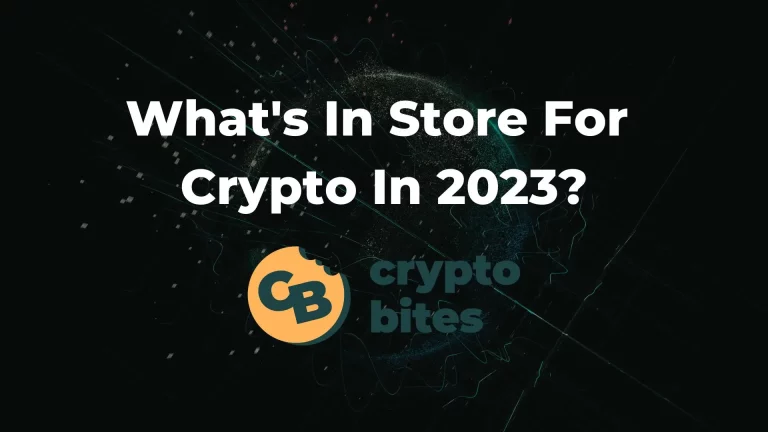
What’s In Store For Crypto In 2023?
2022 has been one of those years that crypto will look back on about as fondly as the rest of us do for 2020. Between rising inflation rates and the meltdowns of major exchanges like FTX and Terra, the cryptocurrency market has taken a $2 trillion hit over the past 12 months.
But while it may not make for the most flattering year in review, the news wasn’t all bad.
Back in March, Ukraine received over $100 million in crypto donations in what one of the country’s officials described as an “economic breakthrough.” 2022 was also the year that Ethereum finally pulled off its highly anticipated “merge.”
But as we head into 2023, the question on many people’s minds is, what’s next?
While some crypto fans are ready to plunge into the new year with a sense of balls-out optimism, others are understandably a bit more cautious. So we’ve decided to do a round-up of expert 2023 crypto predictions.
Here are several key crypto trends to focus on in the new year, for better and worse.
Brace Yourself; Regulations Are Coming
One of the most common misconceptions surrounding crypto is that it runs wild and free, unhampered by the burdens of pesky regulations. A romantic notion perhaps – but not at all the actual case.
The truth is that cryptocurrency has been regulated for years. For example, in Canada, all virtual asset service providers (VASPs) fall under the jurisdiction of FinTRAC and must adhere to strict Know Your Customer (KYC) policies.
In the US, all crypto providers must register with FinCEN and adhere to an ever-evolving list of policies to avoid getting their asses fined off. US crypto regulation also varies from state to state – sometimes by a lot.
What the US really needs to see in the coming year (or years) is more regulation at the Federal level. Similar efforts are being made by countries all over the world. Because let’s face it – it’s time to get everyone on the same damn page.
If Sam Bankman-Fried’s latest $32 billion blunder has taught us anything, maybe a little extra oversight isn’t such a bad thing. While there will always be groups who insist that crypto is all about financial anarchy, the reality is that that ship sailed long ago.
Hopefully, clearer regulations will offer additional protection for investors and open the door to wider real-world implementation.
2023 Bitcoin Price Predictions Are All Over the Board
Will 2023 usher in the end of crypto winter? At this point, the answer you’ll get will largely depend on who you ask.
Many analysts remain skeptical that Bitcoin has seen the bottom of its recent fallout. JPMorgan is predicting BTC may dip as low as $13,000, while Forbes suggests that 2023 may see it drop as low as $10,000.
Others, such as Sayantani Sanyal, seem to be feeling a helluva lot more optimistic. The Analytics Insight analyst recently predicted a breakout year for BTC, with a ceiling as high as $100,000.
While only time will tell who’s right, history proves that Bitcoin’s latest plunge isn’t really anything new.
Back in 2018, BTC took an 84% plunge from $20k to $3k. Then, in mid-2021, it also took a 50% hit before surging to its all-time high of around $69. Hopefully, this is just another bump in its notoriously volatile road.
Crypto’s Impending Bubble Burst
Crypto’s latest antics are starting to feel suspiciously like the dot com bubble of the 1990s. Back then, everybody was throwing money at anything remotely related to the internet.
Ultimately, however, the web’s new novelty wore off, resulting in a massive “bubble burst” in the early 2000s. That was when the tech sector went all survival of the fittest.
While most tech companies didn’t make the cut, the ones that did made their investors a lot of money. When the dust finally settled, companies like Amazon, IBM, and ASML emerged as solid leaders in a sea of laggards.
As the world begins to understand just how wrong an ill-fated crypto investment can go, the odds are that investors are about to get a lot pickier. While leaders like Bitcoin and Ethereum will likely be around for years to come, plenty of smaller projects are unlikely to survive.
Not to harp, but that’s where the importance of research comes in. When the bubble comes crashing down, it’s worth ensuring your money is invested on the winning side.
The Unlimited Potential of NFTs
You’re not alone if you’ve ever questioned the logic behind dropping millions on a virtual cartoon portrait of an ape. Yet the NFT market is now worth billions of dollars.
What many stunned bystanders may not understand is that NFT investors are investing in a lot more than cartoons. Today’s NFTs may be tomorrow’s virtual artifacts from the birth of a revolutionary new form of technology.
In reality, smart contracts are a far more innovative concept than most people give them credit for. They provide a paperless, secure way to produce transparent, traceable contracts.
Companies like Propy (PRO) are among the first to realize that the smart contract has plenty of potential outside of digital art. Propy is a Web3-era real estate company allowing users to buy and sell actual real estate properties as NFTs.
Eco-friendly start-ups like IMPT now offer a similar set-up with carbon credits. As more companies catch on, the odds are that someday you’ll be able to purchase anything from a car to a plane ticket in NFT form.
Fintech’s Bridge Between Crypto and Traditional Finance
Fintech has seen a lot of exciting growth in the past few years and doesn’t show signs of slowing down anytime soon. The recent rise of neobanks (banks that only exist online) indicates that plenty of customers have had it with traditional finance.
Many virtual banks now offer perks like higher interest returns, no late fees, and cashback debit cards. In addition to benefits that put most traditional banks to shame, many neobank have even taken the opportunity to integrate crypto services into their offerings.
Virtual bank Juno now offers a debit card that lets customers pay anywhere using crypto. Quontic offers a Bitcoin rewards checking account, not to mention a wearable ring that works as a debit card.
On the other end of the spectrum, many crypto exchanges are now beginning to offer the same payment services you’d traditionally get from a bank. For example, Coinbase, Binance, and Crypto.com now all offer Visa cards with their own unique benefits.
As the lines between crypto and banking continue to blur, many traditional financial institutions are adopting the “if you can’t beat them, join them” approach. For example, Mastercard recently announced intentions to launch a program designed to make it easier for traditional banks to offer crypto to customers.
All of this is good news when it comes to crypto’s journey to becoming a widely accepted currency.
While 2022 may not have been the ideal year for cryptocurrency, its challenges weren’t enough to kill it either. Fingers crossed that last year’s mishaps will help pave the path forward for the entire crypto community. After all, one exchange’s $32 billion catastrophe is another exchange’s opportunity to ensure it’s got its shit together.




